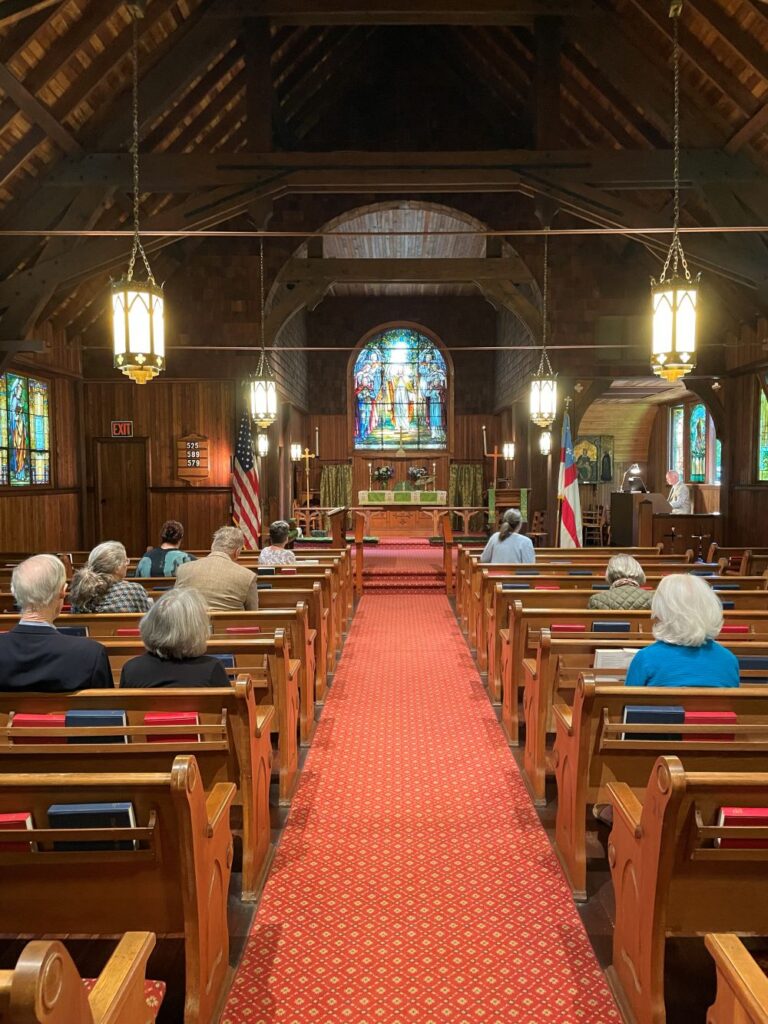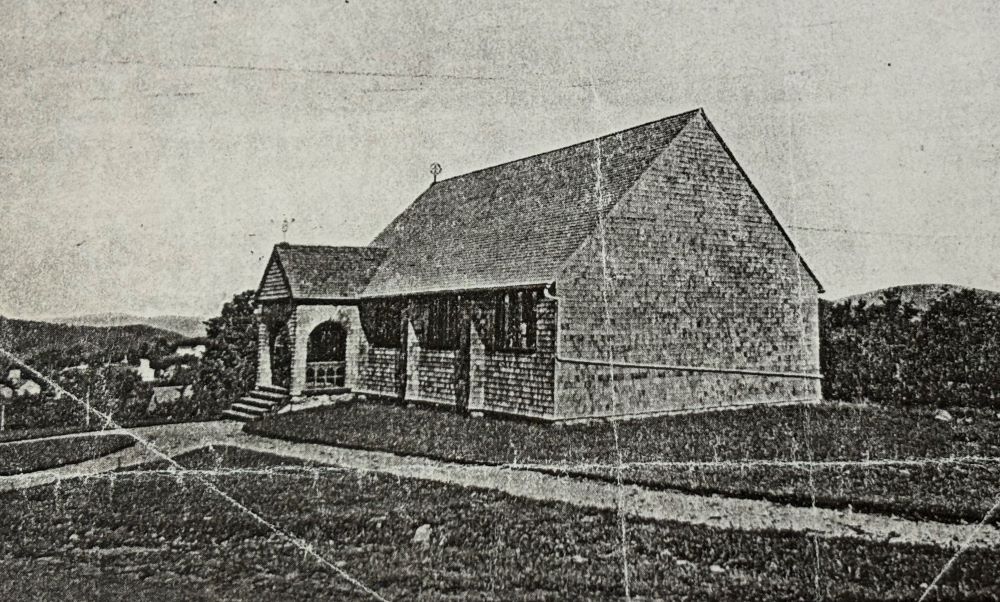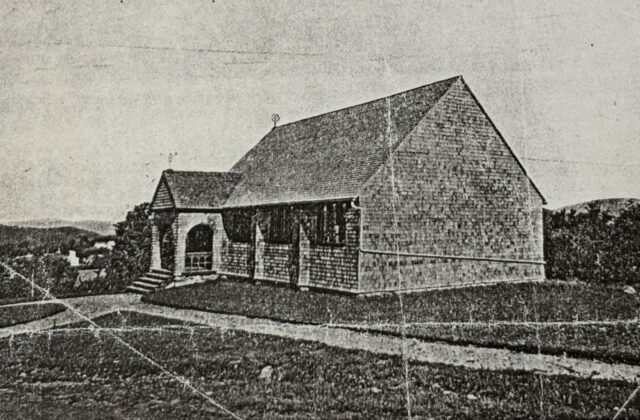Norfolk Past and Present
The Summer Chapel Eases Gracefully Into Its 130 Years
By Elizabeth Bailey

The church has been a haven of faith and fellowship for 130 years.
Ayreslea Rowland Denny began attending services at The Church of the Transfiguration in Norfolk in 1939 on the eve of World War II. A New Yorker, she was a student at the Chapin School in New York City, but her family had been coming to Norfolk for weekends and summers her whole life. “The church was a real oasis for me during the war,” Denny remembers. “I had three brothers overseas in the service, and the church sustained me. I went from seven years [old] till 12 during the war, and war was all I knew.”
Fortunately, all three boys made it home. Denny has remained a member of the congregation, eventually heading up the Bishop’s Committee, the group in charge of organizing services at the church, in the 1990s.
This year, The Church of the Transfiguration, the brown cedar-shingled gem nestled into a stand of cedar trees on Mills Way between Shepard Street and Maple Avenue, celebrates its 130th anniversary (while Denny celebrates her 90th year.)
Roger Miller, long-time Norfolk resident and worshipper at the church, remembers the church’s centennial: “I can recall opening the copper box that had been laid under the cornerstone in 1893.” The following items, among others, were as they had been placed 100 years before: hymnals from 1874 and 1894; the Winsted Evening Citizen of June 23, 1894; a catalog of the Berkeley Divinity School, 1983-4; and the telegram containing the bishop’s license.
The land for the church was donated by Frederick Mills Shepard of East Orange, New Jersey. The architect, Bruce Price, was an innovator in the Shingle Style, which featured in the 7,000-acre planned community in Tuxedo Park, New York and influenced the work of Frank Lloyd Wright and Robert Venturi.
The church’s fine stained-glass windows—not competition for the Tiffany beauties at the Battell Chapel on the village green—are notable as memorials. One honors Olivia Langdon Clemens, wife of Mark Twain, a gift of her daughter Clara. The impressive Marden window was given by his parents in memory of 19-year-old Francis Skiddy Marden, who died in a drowning accident.
The maker of the Marden window had remained a mystery until, on a tip from Barry Webber, director of the Norfolk Historical Society, Norfolk Now contacted David Bleckman, president of J&R Lamb Studios, Inc., who confirmed: “We created two stained glass windows for the Church of the Transfiguration. One window, “Christ with Pilgrims,” was ordered April 1916, and the other, “Memorial Window,” was ordered October of 1916.” Mystery solved.
The church, known as the “Chapel of Ease,” is devoted exclusively to summer worship. It is the only chapel of its kind under the auspices of the Episcopal Diocese of Connecticut. According to Denny, the Rev. G. Ashton Oldham, who later became Episcopal Bishop of Albany, had a summer home in Norfolk. He helped found the church, it was said, because he wanted to earn a bit of extra cash serving as priest during his summer vacation.
Rev. Wendell Phillips, who preached from 1934 to 1963, was the last priest assigned to the church. Since then, the Bishop’s Committee, with the help of the Episcopal Diocese, has arranged for visiting priests and deacons to lead the services. Communion, which used to be celebrated the first Sunday of the month, is now typically offered every Sunday.
Members of the Bishop’s Committee rotate as the Person-in-Charge who makes sure that there is someone to read the lessons, provide flowers for the altar, arrange for food and drink for coffee hour and sometimes lead the Morning Prayer. This summer, on the second Sunday after Memorial Day, Beatrice D. Tirrell, co-chair of the Bishop’s Committee and daughter of Ayreslea Denny, led the service. The soaring soprano of the other co-chair, Kitty Hickcox, also chief of the Norfolk Lions Club Ambulance, made up for the lack of a choir.
Hickox’s marriage to Dan Wuori, celebrated in a packed church in 2014, was one of the last weddings held in the church. Alyson Thomson, a member of the Bishop’s Committee, has worshipped at the church for the last 20 years, during which time, she notes, “My family has had two wedding blessings at the church and five christenings of the resulting babies, which I think demonstrates my enthusiasm for the summer chapel.”
In 1996, a corner of the church property was designated the Memorial Woods, a place where ashes can be scattered. In 2006, the family of Beatrice Carrere Rowland, Denny’s mother, spread her ashes in the woods. The Miller family spread the ashes of Nicholas James Miller in 2007.
Robert Dance, art dealer, curator and chronicler of Hollywood stars, first came to the church 21 years ago. “I came here as an Episcopalian and because the church is beautiful,” he says. “I keep on coming because it gives me a chance to spend an hour a week in contemplation, to step out of my life and be introspective. Then I go to coffee hour, which is time spent in community.”
Coffee hour is normally held under the large maple tree that spreads its shade over the handkerchief-sized lawn. Lemonade or iced-tea and baked goods balance on the rickety bridge table while worshippers chat and, from time to time, discuss the sermon. “I like the variety of the sermons,” notes Miller. “Some are dial-in, but some are quite thought-provoking.”
In Norfolk’s pre-war heyday, the scene was apparently more “High Society” than Barbara Pym novel. Coffee hour moved from the Chapel of Ease to the Laurel Way home of Margery Dana. There, Webber was told, “martinis and manhattans were served from a silver tray.”
In recent years, with waning attendance and fewer weddings or baptisms, the Bishop’s Committee has involved itself in outreach to the wider community, supporting organizations such as Friends In Service to Humanity of Northwest Connecticut, Bishops’ Fund for Children, Bishops’ Discretionary Fund, Church of Christ: Minister’s Discretionary Fund, the Steeple Fund, Norfolk Food Pantry and Battell Arts Foundation.
But, above all, it remains a worshiping community.

A photograph of the church from August 1899 reveals Norfolk’s tree-free views.

